
Molarity is one of the most commonly used concentration units for solutions and is abbreviated as “M.”
Molarity is calculated by determining the number of moles of the solute, or the substance being dissolved, in 1 liter of solution. In other words, molarity is the number of moles/liter. This is summarized as follows:
image attached
What is the molarity of a solution prepared from 29.2 grams of KNO 3 in 425 milliliters of solutions?
- 0.0687 M KNO3
- 0.680 M KNO3
- 0.815 M KNO3
- 1.47 M KNO3
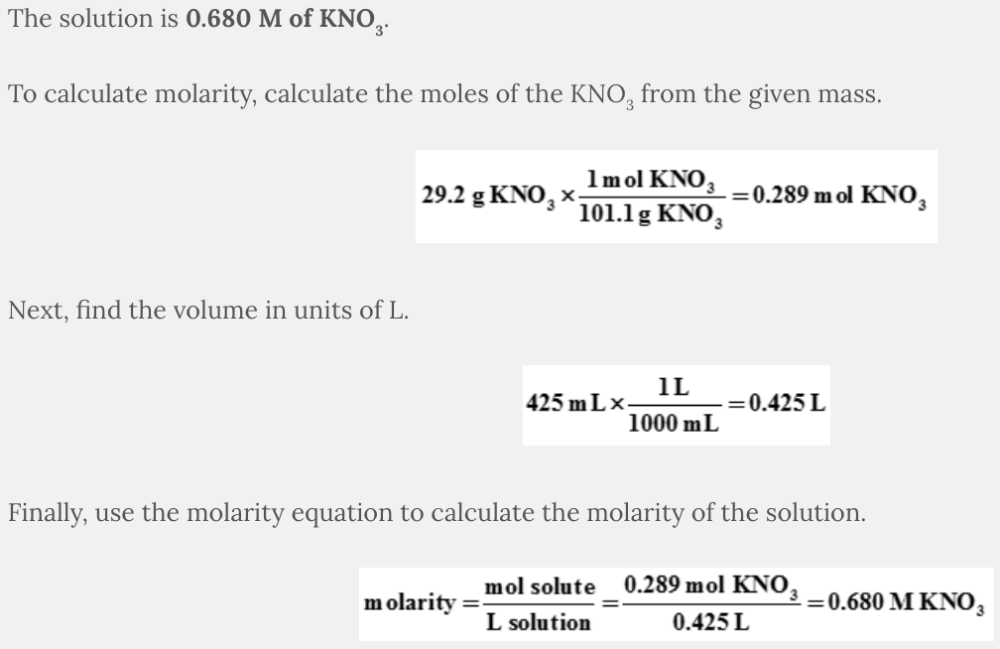
0.680 M KNO 3

Molarity is one of the most commonly used concentration units for solutions and is abbreviated as “M.”
Molarity is calculated by determining the number of moles of the solute, or the substance being dissolved, in 1 liter of solution. In other words, molarity is the number of moles/liter. This is summarized as follows:
image attached
What is the molarity of a solution prepared from 19.4 g NaCl in 300.0 mL of solution?
- 1.11 M NaCl
- 0.0996 M NaCl
- 1.00 M NaCl
- 0.0647 M NaCl
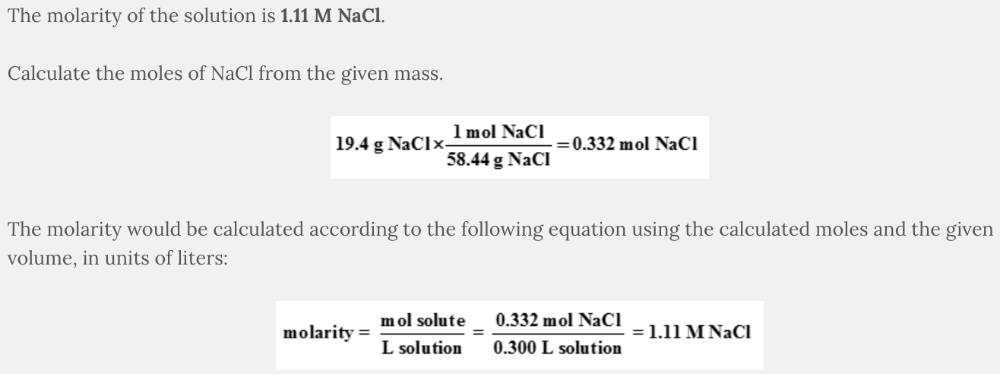
1.11 M NaCl
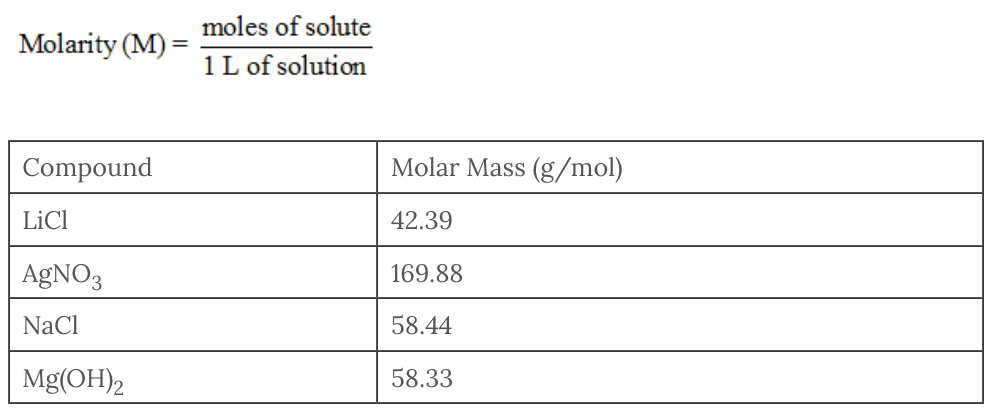
Molarity is one of the most commonly used concentration units for solutions and is abbreviated as “M.”
Molarity is calculated by determining the number of moles of the solute, or the substance being dissolved, in 1 liter of solution. In other words, molarity is the number of moles/liter. This is summarized as follows:
image attached
Which solution has the highest molarity when 25.0 grams of the solute is dissolved in 250.0 milliliters of solution?
- LiCl
- Mg(OH)2
- NaCl
- AgNO3
LiCl
Ex.
The solution prepared from LiCl will have the highest molarity.
The mass of all four samples is the same and LiCl has the smallest molar mass, so it will have the greatest number of moles. Therefore, the LiCl solution will have the highest molarity.
The equation for a chemical reaction can be written in multiple ways. The most frequent method is to write molecular equations which show all substances as compounds or elements. Complete ionic and net ionic equations provide a more accurate representation of the reaction because they show the dissociation of substances in water. A complete ionic equation shows all aqueous substances as their component ions while a net ionic equation omits any spectator ions.
Select the net ionic equation for the reaction between HCl and NaOH.
- HCl(aq) + NaOH(aq) → H2O(l) + NaCl(aq)
- No reaction
- H+(aq) + OH−(aq) → H2O(l)
- H+(aq) + Cl−(aq) + Na+(aq) + OH−(aq) → H2O(l) + Cl−(aq) + Na+(aq)
- HCl(aq) + NaOH(aq) → H+(aq) + Cl−(aq) + Na+(aq) + OH−(aq)
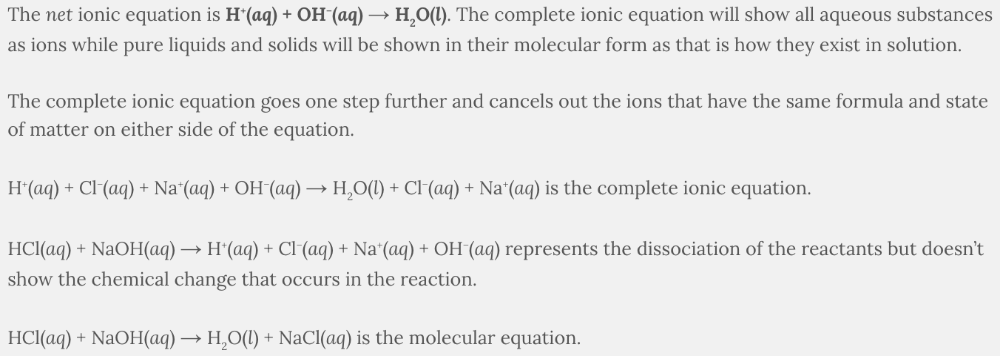
H + ( aq ) + OH − ( aq ) → H 2 O( l )
What is the oxidation state of silicon in SiO 3 2− ?
- −2
- 0
- +4
- +2
- −4

+4
Precipitation reactions are the result of two aqueous substances reacting to form a solid product.
Identify the solid product formed, if any, from the reaction of (NH 4 ) 2 CO 3 and Mg(NO 3 ) 2 .
- Mg(NO3)2
- NH4NO3
- No solid product formed.
- MgCO3
- (NH4)2CO3
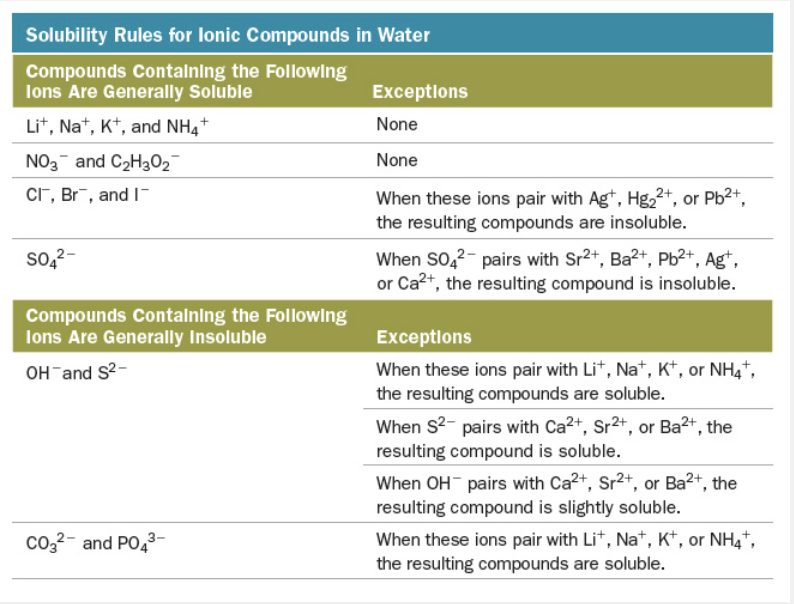
MgCO 3
Ex.
The solid product formed is MgCO 3 .
To find the potential products, swap the anions between the cations. The cation from the first reactant is paired with the anion from the second, while the cation from the second reactant is paired with the anion from the first.
The reaction between the two substances is:
Mg(NO 3 ) 2 ( aq ) + (NH 4 ) 2 CO 3 ( aq ) → MgCO 3 ( s ) + 2 NH 4 NO 3 ( aq )
MgCO 3 is the only insoluble compound, so it will precipitate from the solution. NH 4 NO 3 is soluble in water, so it will not precipitate. Mg(NO 3 ) 2 and (NH 4 ) 2 CO 3 are reactants, so they can’t be products, and they are soluble in water.
What is the oxidation state of sulfur in Na 2 S 2 O 3 ?
- +2
- −2
- +6
- +4
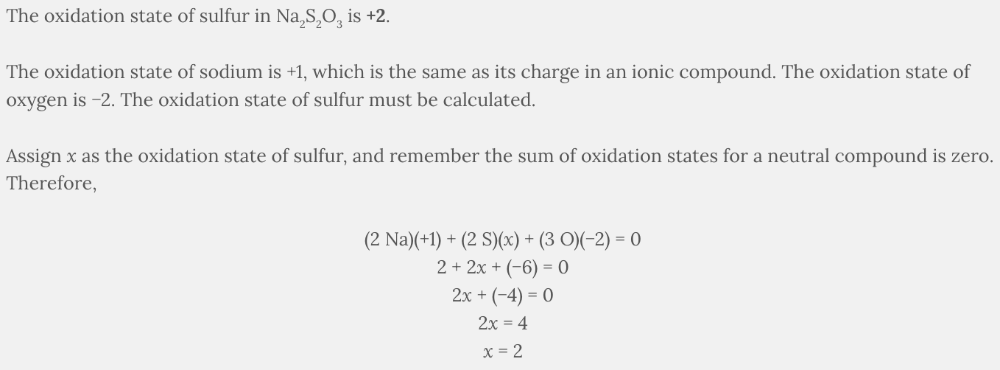
+2

Molarity is one of the most commonly used concentration units for solutions and is abbreviated as “M.”
Molarity is calculated by determining the number of moles of the solute, or the substance being dissolved, in 1 liter of solution. In other words, molarity is the number of moles/liter. This is summarized as follows:
What is the molarity of a solution prepared from 10.0 grams of methanol (CH 3 OH, density = 0.792 g/mL) with 125.0 milliliters of ethanol (CH 3 CH 2 OH)? Assume the volumes are additive.
- 0.800 M CH3OH
- 0.725 M CH3OH
- 2.27 M CH3OH
- 2.50 M CH3OH
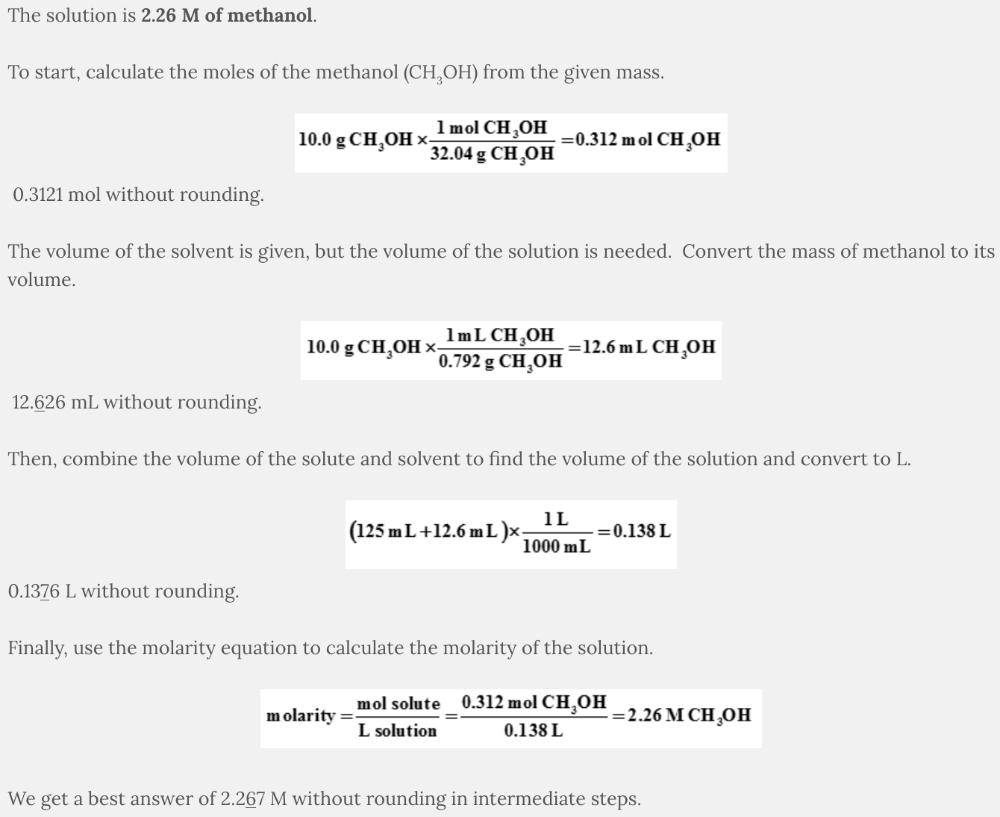
2.27 M CH 3 OH
What is the oxidation state of iodine in IO 3 − ?
- −1
- +7
- +5
- +1

+5
Strong electrolytes dissociate completely, weak electrolytes dissociate partially, and nonelectrolytes do not dissociate in water. The equilibrium arrow ( ⇌ ) is used to indicate compounds that partially dissociate.
Which equation best represent s the behavior of acetic acid, HC 2H 3 O 2 , in water?
- HC2H3O2(l) ⇌ H+(aq) + C2H3O2−(aq)
- HC2H3O2(l) → H+(aq) + C2H3O2−(aq)
- HC2H3O2(l) ⇌ HC2H3O2(aq)
- HC2H3O2(l) → HC2H3O2(aq)
HC2H3O2 ( l ) ⇌ H + ( aq ) + C 2H 3 O 2 − ( aq )
Ex.
Acetic acid in water is best represented by HC2H3O2 ( l ) ⇌ H + ( aq ) + C2H3O2 − ( aq ) .
Acetic acid, HC2H3O2 , is a weak electrolyte, so it will partially dissociate in water. The equilibrium arrow ( ⇌ ) is used to indicate the compound partially dissociates. Strong electrolytes dissociate completely, weak electrolytes dissociate partially, and nonelectrolytes do not dissociate in water.
What volume of solution is prepared when 25.0 g of NaCl is added to enough water to make a 2.50 M NaCl solution?
- 0.585 L
- 0.935 L
- 1.07 L
- 0.171 L
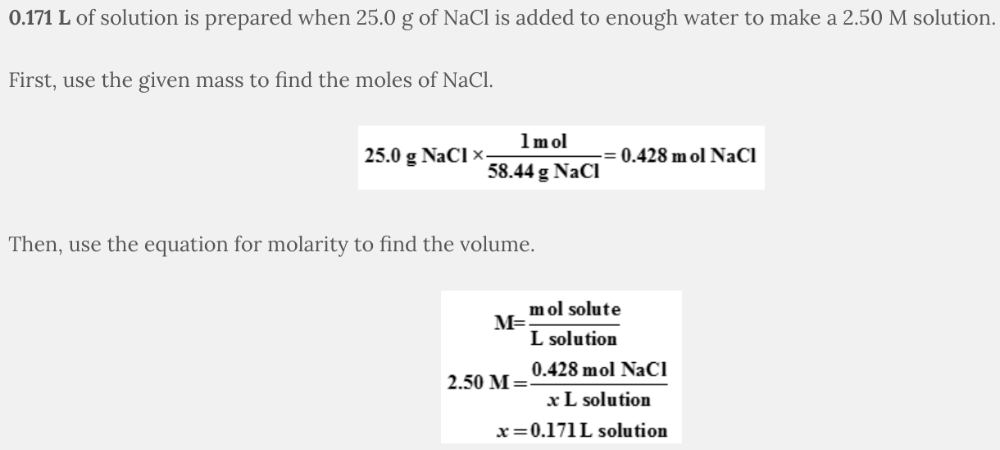
0.171 L
Solution stoichiometry allows chemists to determine the volume of reactants or products involved in a chemical reaction when the chemical substances are dissolved in water. Instead of using mass to calculate the resulting amount of reactants or products, molarity and volume will be used to calculate the moles of substances.
A 35.00-mL sample of a 0.200 M solution of H 3 PO 4 reacts with excess NaOH. What mass of H 2 O is produced in the reaction?
H 3 PO 4 ( aq ) + 3 NaOH( aq ) → Na 3 PO 4 ( aq ) + 3 H 2 O( l )
- 0.126 g H2O
- 1.05 g H2O
- 0.0420 g H2O
- 0.378 g H2O

0.378 g H 2 O
Electrolytes are substances that are able to conduct an electrical current as they form ions when they dissolve in water.
Strong electrolytes completely dissociate or break up into their ions. Soluble ionic solids, strong acids, and strong bases are all strong electrolytes.
Weak electrolytes partially dissociate or break up into their ions. Weak acids and weak bases are weak electrolytes.
Nonelectrolytes are unable to conduct an electrical current as they dissolve as molecules. Covalent compounds are nonelectrolytes.
Which of the following is a nonelectrolyte?
- Hydrochloric acid, HCl
- Ammonium chloride, NH4Cl
- Lactose, C12H22O11
- Water, H2O
Lactose, C 12 H 22 O 11
Ex.
Lactose, C 12 H 22 O 11 , is a nonelectrolyte as it is a covalent compound. Covalent compounds dissolve as molecules and are unable to conduct electricity.
Hydrochloric acid is a strong electrolyte as it is a strong acid. Ammonium chloride is also a strong electrolyte as it is an ionic compound. Water is a weak electrolyte as it is a weak acid.
What is the oxidation state of phosphorus in H 3 PO 4 ?
- +1
- +5
- +3
- +4
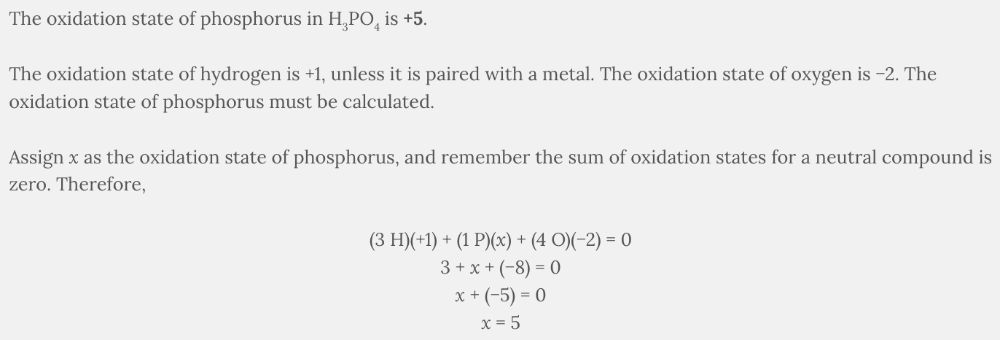
+5
The equation for a chemical reaction can be written in multiple ways. The most frequent method is to write molecular equations which show all substances as compounds or elements. Complete ionic and net ionic equations provide a more accurate representation of the reaction because they show the dissociation of substances in water. A complete ionic equation shows all aqueous substances as their component ions while a net ionic equation omits any spectator ions.
Select the complete ionic equation for the reaction between AgNO 3 and NaCl.
- Ag+(aq) + NO3−(aq) + Na+(aq) + Cl−(aq) → AgCl(s) +NO3-(aq) + Na+(aq)
- Ag+(aq) + Cl−(aq) → AgCl(s)
- AgNO3(aq) + NaCl(aq) → Ag+(aq) + NO3−(aq) + Na+(aq) + Cl−(aq)
- AgNO3(aq) + NaCl(aq) → AgCl(s) + NaNO3(aq)

Ag + ( aq ) + NO 3 − ( aq ) + Na + ( aq ) + Cl − ( aq ) → AgCl( s ) + NO 3 -(aq) + Na + ( aq )
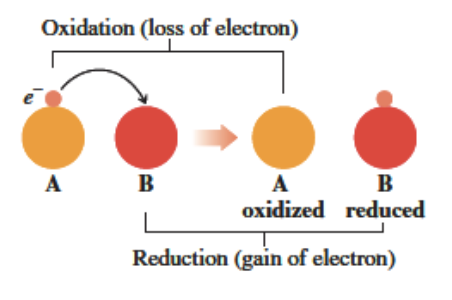
Oxidation-reduction reactions are more commonly referred to as “redox reactions.” Redox reactions involve the simultaneous reduction and oxidation of two different chemicals due to the transfer of electrons.
Reduction occurs when an atom has gained electrons, resulting in a decrease in the oxidation state of that atom. The decrease in oxidation state occurs due to the gain of negatively charged electrons.
Oxidation occurs when an atom has lost electrons, resulting in an increase in the oxidation state of that atom. The increase in oxidation state occurs due to the loss of negatively charged electrons.
By comparing the oxidation states before and after a reaction occurs, you can determine if a substance was reduced or oxidized.
In the reaction shown below, which substance is reduced?
Mg 0 ( s ) + Zn 2+ ( aq ) → Mg 2+ ( aq ) + Zn 0 ( s )
- Mg0(s)
- Zn2+(aq)
- Mg2+(aq)
- Zn0(s)
Zn 2+ ( aq )
Ex.
Zn2+(aq) is reduced to Zn 0 ( s ), as the oxidation state decreases from +2 to 0.
Mg 0 ( s ) + Zn 2+ ( aq ) → Mg 2+ ( aq ) + Zn 0 ( s )
A decrease in the oxidation state occurs due to reduction, as electrons are gained, while an increase in oxidation state is due to oxidation, as electrons are lost. Mg 0 ( s ) is oxidized to Mg 2+ ( aq ) in this reaction.
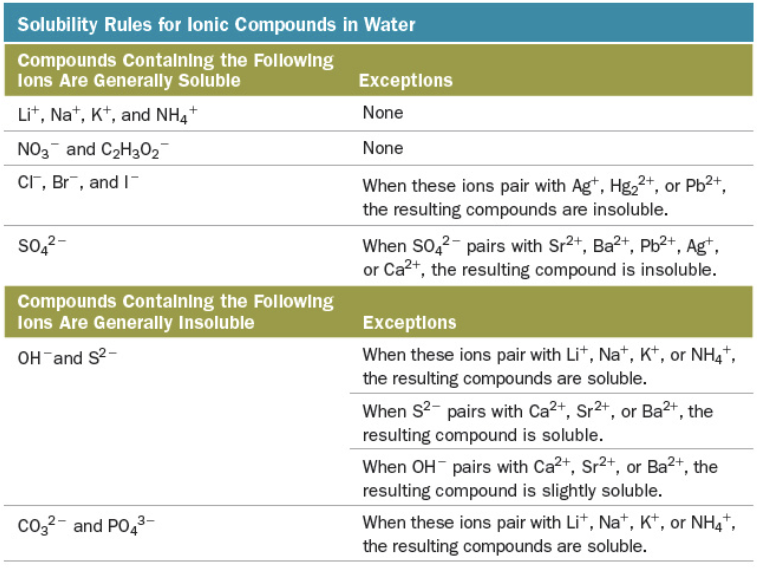
Many ionic compounds, or salts, such as sodium chloride, are water-soluble. These compounds are referred to as soluble salts. When a soluble salt is placed in water, the ions separate or dissociate, creating a solution.
There are a number of ionic compounds that are not water-soluble. These compounds are referred to as insoluble salts, as they either stay as a solid, or form a solid, when placed in water.
Salts are soluble or insoluble based on interactions between the solute and the solvent. The solubility rules are arbitrary empirical rules based on a test such as ability to form a 0.1 M solution at 25 °C, or ability to dissolve one gram of solute in one liter of water. Many insoluble substances will dissolve less than the amount required to be considered soluble. We study these substances in chapter 18.
In using these solubility rules, for the salt to be considered water-soluble, the cation or anion must be able to dissolve in water.
The table of solubility rules provided here could differ from the table listed in your text. Using the table provided here, please answer the following question: Which of the following salts is insoluble in water?
- KNO3
- BaS
- CaSO4
- MgBr2
CaSO 4
Ex.
CaSO 4 is insoluble in water. Sulfates are generally soluble, but the compound with the calcium ion, Ca 2+ , is an exception.
MgBr 2 is soluble because halides are soluble. KNO 3 is soluble because it contains both soluble ions, potassium ion, and nitrate. BaS is soluble; although sulfides are generally insoluble, the compound formed with the barium ion, Ba 2+ , is an exception.
Electrolytes are substances that are able to conduct an electrical current, as they form ions when they dissolve in water.
Strong electrolytes completely dissociate or break up into their ions. Soluble ionic solids, strong acids, and strong bases are all strong electrolytes.
Weak electrolytes partially dissociate or break up into their ions. Weak acids and weak bases are weak electrolytes.
Nonelectrolytes are unable to conduct an electrical current, as they dissolve as molecules. Covalent compounds are nonelectrolytes.
Which of the following is a strong electrolyte?
- Potassium iodide, KI
- Acetic acid, CH3COOH
- Glucose, C6H12O6
- Methanol, CH3OH
Potassium iodide, KI
Ex.
Potassium iodide, KI , is a strong electrolyte as it is a soluble ionic compound. Soluble ionic compounds completely dissociate into their ions, which is the definition of a strong electrolyte.
Acetic acid is a weak electrolyte as it is a weak acid. Methanol and glucose are both nonelectrolytes as they are both covalent compounds.

Molarity is one of the most commonly used concentration units for solutions and is abbreviated as “M”.
Molarity is calculated by determining the number of moles of the solute, or the substance being dissolved, in 1 liter of solution. In other words, molarity is the number of moles/liter. This is summarized as follows:
What is the molarity of a solution containing 2.8 mol of LiCl and a volume of 5.00 × 10 2 mL?
- 1.4 M LiCl
- 5.6 M LiCl
- 0.17 M LiCl
- 6.0 M LiCl

5.6 M LiCl

Solution stoichiometry allows chemists to determine the volume of reactants or products involved in a chemical reaction when the chemical substances are dissolved in water. Instead of using mass to calculate the resulting amount of reactants or products, molarity and volume will be used to calculate the moles of substances.
Select the missing conversion factor for the following set of calculations:
Assume 0.38 L of a 2.8 M solution of magnesium chloride, MgCl 2 , reacts with a 2.3 M solution of silver nitrate, AgNO 3 , to produce silver chloride, AgCl, and magnesium nitrate, Mg(NO 3 ) 2 . The problem requires that you determine the volume of silver nitrate, AgNO 3 , needed for the reaction to occur.
MgCl 2 ( aq ) + 2 AgNO 3 ( aq ) → 2 AgCl( s ) + Mg(NO 3 ) 2 ( aq )
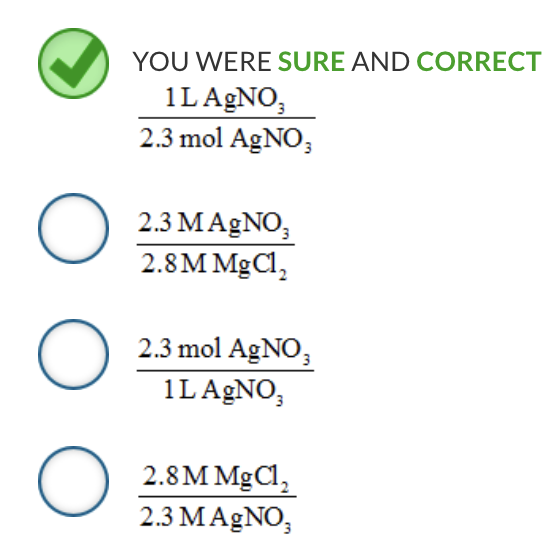
Ex.
The missing conversion needed to complete the calculation is the molarity of silver nitrate
1 L AgNO3 / 2.3 mol Ag NO3
With any other conversion factor, the units would not cancel correctly resulting in an incorrect answer.
What volume of 4.00 M HCl should be diluted to prepare 75.00 mL of a 1.25 M HNO 3 solution?
- 2.40 mL
- 23.4 mL
- 42.7 mL
- 41.7 mL

23.4 mL

Molarity is one of the most commonly used concentration units for solutions and is abbreviated as “M.”
Molarity is calculated by determining the number of moles of the solute, or the substance being dissolved, in 1 liter of solution. In other words, molarity is the number of moles/liter. This is summarized as follows:
What is the molarity of a solution having 1.4 mol of sodium chloride, NaCl, and a volume of 525 mL?
- 2.7 M NaCl
- 0.38 M NaCl
- 3.8 × 102 M NaCl
- 0.0027 M NaCl

2.7 M NaCl
What is the oxidation state of manganese in KMnO 4 ?
- +5
- +3
- +7
- +1
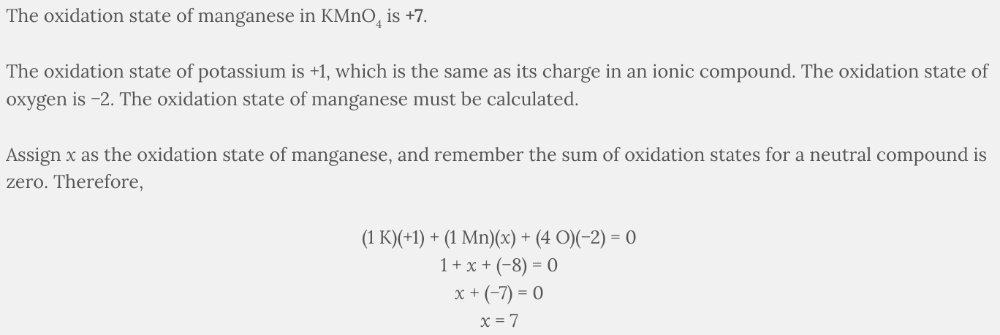
+7

Oxidation-reduction reactions are more commonly referred to as “redox reactions.” Redox reactions involve the simultaneous reduction and oxidation of two different chemicals due to the transfer of electrons.
A reducing agent causes another substance to be reduced. During the reaction, the reducing agent is oxidized. The electrons lost by the reducing agent are gained by another chemical, which is reduced.
An oxidizing agent causes another substance to be oxidized. During the reaction, the oxidizing agent is reduced.
Which substance is the oxidizing agent in the following reaction?
2 Au 3+ ( aq ) + 6 I − ( aq ) → 2 Au 0 ( s ) + 3 I 2 0 ( s )
- I20(s)
- Au3+(aq)
- I-(aq)
- Au0(s)
Au 3+ ( aq )
Ex.
Au 3+ (aq) is the oxidizing agent as it causes I - ( aq ) to be oxidized to I 2 0 ( s ). I − ( aq ) is oxidized as the oxidation state increases from −1 to 0.
2 Au 3+ ( aq ) + 6 I − ( aq ) → 2 Au 0 ( s ) + 3 I 2 0 ( s )
In the process, Au 3+ ( aq ) is reduced to Au 0 ( s ). The species that is oxidized is the reducing agent, and the species that is reduced is the oxidizing agent.

Oxidation-reduction reactions are more commonly referred to as “redox reactions.” Redox reactions involve the simultaneous reduction and oxidation of two different chemicals due to the transfer of electrons.
Reduction occurs when an atom has gained electrons, resulting in a decrease in the oxidation state of that atom. The decrease in oxidation state occurs due to the gain of negatively charged electrons.
Oxidation occurs when an atom has lost electrons, resulting in an increase in the oxidation state of that atom. The increase in oxidation state occurs due to the loss of negatively charged electrons.
By comparing the oxidation states before and after a reaction occurs, you can determine if a substance was reduced or oxidized.
In the reaction shown below, which substance is oxidized?
2 Fe 3+ ( aq ) + Sn 2+ ( aq ) → 2 Fe 2+ ( aq ) + Sn 4+ ( aq )
- Sn4+(aq)
- Sn2+(aq)
- Fe3+(aq)
- Fe2+(aq)
Sn 2+ ( aq )
Ex.
Sn 2+ (aq) is oxidized to Sn 4+ ( aq ), as the oxidation state increases from +2 to +4.
2 Fe 3+ ( aq ) + Sn 2+ ( aq ) → 2 Fe 2+ ( aq ) + Sn 4+ ( aq )
A decrease in the oxidation state occurs due to reduction, as electrons are gained, while an increase in oxidation state is due to oxidation, as electrons are lost. Fe 3+ ( aq ) is reduced to Fe 2+ ( aq ) in the reaction.
What is the final volume when 20.00 mL of 3.00 M NaCl solution is diluted to a final concentration of 0.100 M?
- 150. mL
- 167 mL
- 60.0 mL
- 600. mL
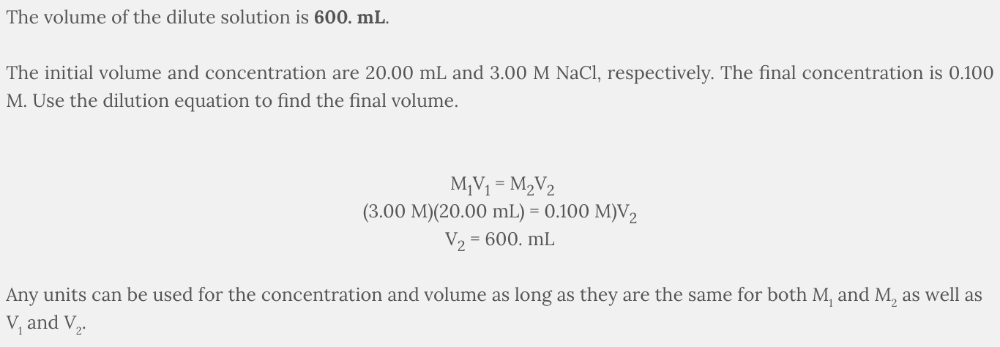
600. mL

Solution stoichiometry allows chemists to determine the volume of reactants or products involved in a chemical reaction when the chemical substances are dissolved in water. Instead of using mass to calculate the resulting amount of reactants or products, molarity and volume will be used to calculate the moles of substances.
Select the missing conversion factor for the following set of calculations:
Assume 0.42 L of a 0.95 M solution of nickel(II) chloride, NiCl 2 , reacts with a 1.5 M solution of sodium hydroxide, NaOH, to produce nickel(II) hydroxide, Ni(OH) 2 , and sodium chloride, NaCl. The problem requires that you determine the volume of sodium hydroxide, NaOH, needed for the reaction to occur.
NiCl 2 ( aq ) + 2 NaOH( aq ) → Ni(OH) 2 ( s ) + 2 NaCl( aq )
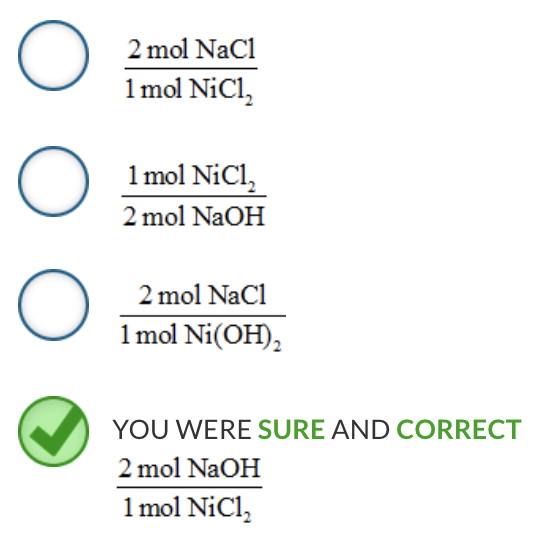
The missing conversion needed to complete the calculation is the mole-to-mole ratio of nickel(II) chloride to sodium hydroxide:
2 mol NaOH / 1 mole NiCl2
With any other conversion factor, the units would not cancel correctly resulting in an incorrect answer.
What mass of KBr is present in 75.0 mL of 0.250 M KBr solution?
- 0.158 g
- 0.448 g
- 2.23 g
- 6.35 g

2.23 g

Solution stoichiometry allows chemists to determine the volume of reactants or products involved in a chemical reaction when the chemical substances are dissolved in water. Instead of using mass to calculate the resulting amount of reactants or products, molarity and volume will be used to calculate the moles of substances.
Select the missing conversion factor for the following set of calculations:
Assume 0.25 L of a 1.8 M solution of aluminum sulfate, Al 2 (SO 4 ) 3 , reacts with a 4.2 M solution of sodium hydroxide, NaOH, to produce sodium sulfate, Na 2 SO 4 , and aluminum hydroxide, Al(OH) 3 . The problem requires that you determine the volume of sodium hydroxide, NaOH, needed for the reaction to occur.
Al 2 (SO 4 ) 3 ( aq ) + 6 NaOH( aq ) → 3 Na 2 SO 4 ( aq ) + 2 Al(OH) 3 ( s )
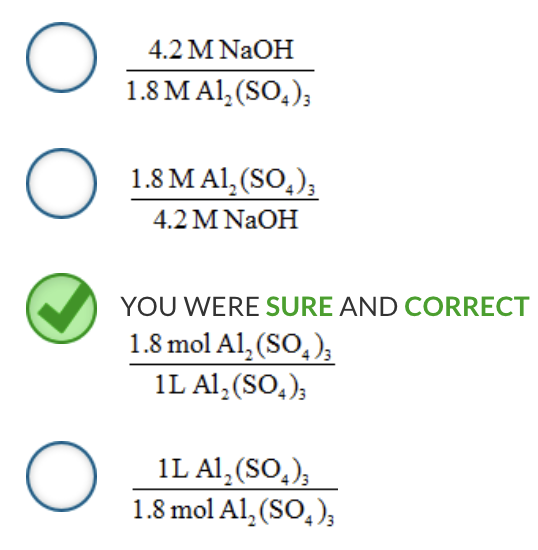
Ex.
The missing conversion needed to complete the calculation is the molarity of aluminum sulfate:
1.8 mol Al2(SO4)3 / 1 L Al2(SO4)3
With any other conversion factor, the units would not cancel correctly resulting in an incorrect answer.

Oxidation-reduction reactions are more commonly referred to as “redox reactions.” Redox reactions involve the simultaneous reduction and oxidation of two different chemicals due to the transfer of electrons.
Reduction occurs when an atom has gained electrons, resulting in a decrease in the oxidation state of that atom. The decrease in oxidation state occurs due to the gain of negatively charged electrons.
Oxidation occurs when an atom has lost electrons, resulting in an increase in the oxidation state of that atom. The increase in oxidation state occurs due to the loss of negatively charged electrons.
By comparing the oxidation states before and after a reaction occurs, you can determine if a substance was reduced or oxidized.
In the reaction shown below, which substance is oxidized?
Al 0 ( s ) + Cr 3+ ( aq ) → Al 3+ ( aq ) + Cr 0 ( s )
- Al3+(aq)
- Cr3+(aq)
- Cr0(s)
- Al0(s)

Al 0 ( s )

Oxidation-reduction reactions are more commonly referred to as “redox reactions.” Redox reactions involve the simultaneous reduction and oxidation of two different chemicals due to the transfer of electrons.
A reducing agent causes another substance to be reduced. During the reaction, the reducing agent is oxidized. The electrons lost by the reducing agent are gained by another chemical, which is reduced.
An oxidizing agent causes another substance to be oxidized. During the reaction, the oxidizing agent is reduced.
Which substance is the reducing agent in the following reaction?
Fe 2 O 3 ( s ) + 3 CO( g ) → 2 Fe( s ) + 3 CO 2 ( g )
- CO(g)
- Fe2O3(s)
- CO2(g)
- Fe(s)
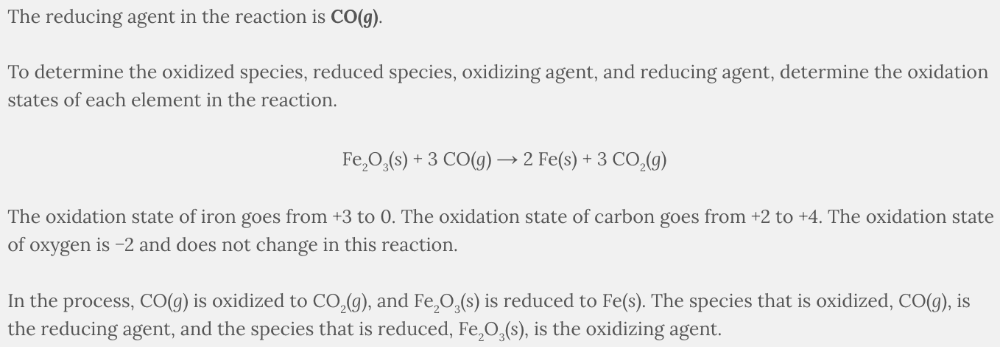
CO( g )
A 25.00-mL sample of 6.00 M HCl solution is diluted to a new volume of 85.00 mL. What is the concentration of the dilute solution?
- 1.76 M
- 0.568 M
- 2.82 M
- 2.04 M
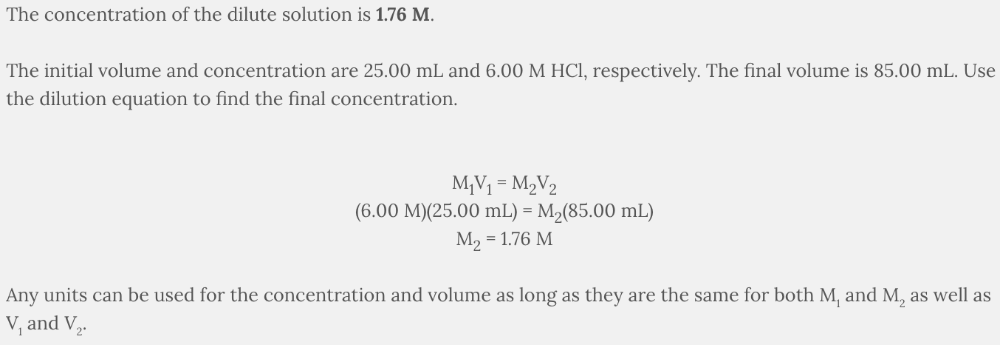
1.76 M
Oxidation-reduction reactions are more commonly referred to as “redox reactions.” Redox reactions involve the simultaneous reduction and oxidation of two different chemicals due to the transfer of electrons.
Reduction occurs when an atom has gained electrons, resulting in a decrease in the oxidation state of that atom. The decrease in oxidation state occurs due to the gain of negatively charged electrons.
Oxidation occurs when an atom has lost electrons, resulting in an increase in the oxidation state of that atom. The increase in oxidation state occurs due to the loss of negatively charged electrons.
By comparing the oxidation states before and after a reaction occurs, you can determine if a substance was reduced or oxidized.
In the reaction shown below, which substance is oxidized?
Ca 0 ( s ) + Pb 2+ ( aq ) → Ca 2+ ( aq ) + Pb 0 ( s )
- Ca2+(aq)
- Pb2+(aq)
- Ca0(s)
- Pb0(s)
Ca 0 ( s )
Ex.
Ca 0 ( s ) is oxidized to Ca 2+ ( aq ), as the oxidation state increases from 0 to +2.
Ca 0 ( s ) + Pb 2+ ( aq ) → Ca 2+ ( aq ) + Pb 0 ( s )
A decrease in the oxidation state occurs due to reduction, as electrons are gained, while an increase in oxidation state is due to oxidation, as electrons are lost. Pb 2+ ( aq ) is reduced to Pb 0 ( s ) in this reaction.